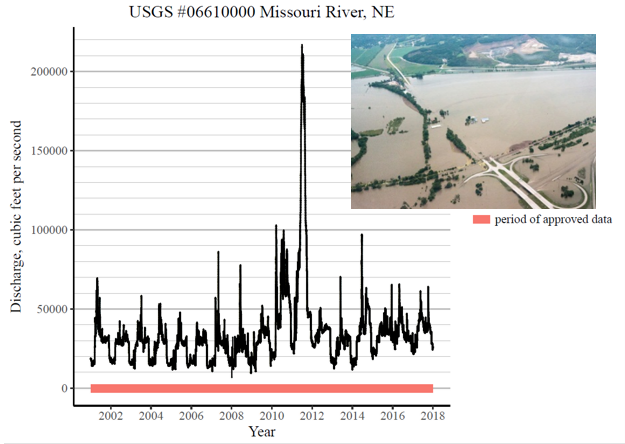Melding Adaptive Management and Climate Change Adaptation

David Marmorek
Lead Scientist | Senior Partner, ESSA Bio | in
Marc Nelitz
Sr. Systems Ecologist | Adaptive Management Lead, ESSA Bio | in
Jimena Eyzaguirre
International Team Director | Climate Change Adaptation Lead, ESSA Bio | in
Carol Murray
Sr. Partner | Adaptive Management Lead, ESSA Bio | in
Clint Alexander
Introduction
Adaptive management (AM) is a rigorous approach to implementing, monitoring and evaluating actions, so as to learn and adjust those actions. Climate change adaptation (CCA) is an approach to plan and implement actions to reduce risks from climate variability and climate change, and to exploit beneficial opportunities. ESSA has been applying the mindset and principles of AM for more than four decades in 40 countries. Within North America, a predominant focus of our work has been in restoring watersheds and recovering species at risk. Since 2006, we have been developing plans for Climate Change Adaptation (CCA) – both in North America and internationally.
Over the last decade, it has become clear to us that the uncertainties created by landscape and continent-scale changes in climate can potentially have equal or greater effects on ecosystems and species than the local uncertainties traditionally considered in AM projects. AM is already difficult, particularly at larger scales, and climate change makes it harder. The challenges from climate change include uncharted territory of hydrological variation, climate-driven limitations on feasible management actions, extreme events that may destroy habitat restoration sites, and large social and economic impacts that outweigh ecological considerations. Bernardt et al., (2005) estimated that at least $14 to $15 billion was spent on the restoration of streams and rivers within the continental United States between 1990 and 2003, an average of more than $1 billion a year. If we ignore climate change when we plan AM projects to restore ecosystems and recover species at risk, we risk wasting large investments and undermining public support for such projects. On the flip side, extreme events brought by climate change may create habitats, restore watershed processes and test hypotheses, as well as catalyze efforts to conserve water, reduce the risk of disasters, and manage flow in real-time.
We’ve recently published a paper arguing that AM practitioners need to apply the methods of Climate Change Adaptation (CCA) in their projects, and expand the scale at which they define the problem they’re trying to solve (Marmorek et al. 2019). Tables 1 and 2 in Marmorek et al. (2019) compare the principles and the procedures of AM and CCA. This insight piece conveys the essence of our arguments in that paper, updated to reflect recent events, and our evolving insights.
What’s going on?
Climate change is leading to increasing variability in weather both within and between years. These strong perturbations are revealing connections within linked ecological-social-economic systems that are often only apparent in retrospect. Let’s take a brief look at recent events in British Columbia (BC). Warmer winters since the late 1970’s have led to two outbreaks of mountain pine beetle, which killed lodgepole pine and other tree species across more than 18 million ha of BC’s Interior, leading to deforestation through tree mortality, greater susceptibility to fires, salvage logging and flipping the region from a carbon sink to a carbon source (Kurz et al. 2008, Alfaro et al. 2015, Canadian Forest Service 2021). During June of 2021, BC experienced an unprecedented heat dome, causing record temperatures (up to 49.6o C in Lytton BC), widespread fires including the destruction of Lytton, the burning of 870,000 ha of (third worst on record) and almost 600 heat-related deaths in Vancouver. The fall of 2021 brought a series of seven atmospheric rivers, causing tremendous flood and landslide damage to highways, farms and communities, likely the most expensive weather event in Canadian history (Environment Canada 2021). The flooding and landslides were made worse by the previous summer’s fires, which accelerated rates of runoff due to both the absence of vegetation and reduced water percolation through fire-melted organic layers of soil (Baum et al. 2021).
These events in BC demonstrate the need to rethink how we design infrastructure (and ecosystem actions) to accommodate more extreme weather and altered watershed processes driven by climate change. They are a more extreme example of patterns that we’ve seen in five AM projects during the last decade, all of which involved watershed restoration and recovery of listed species, across a range of basin scales (Figure 1)
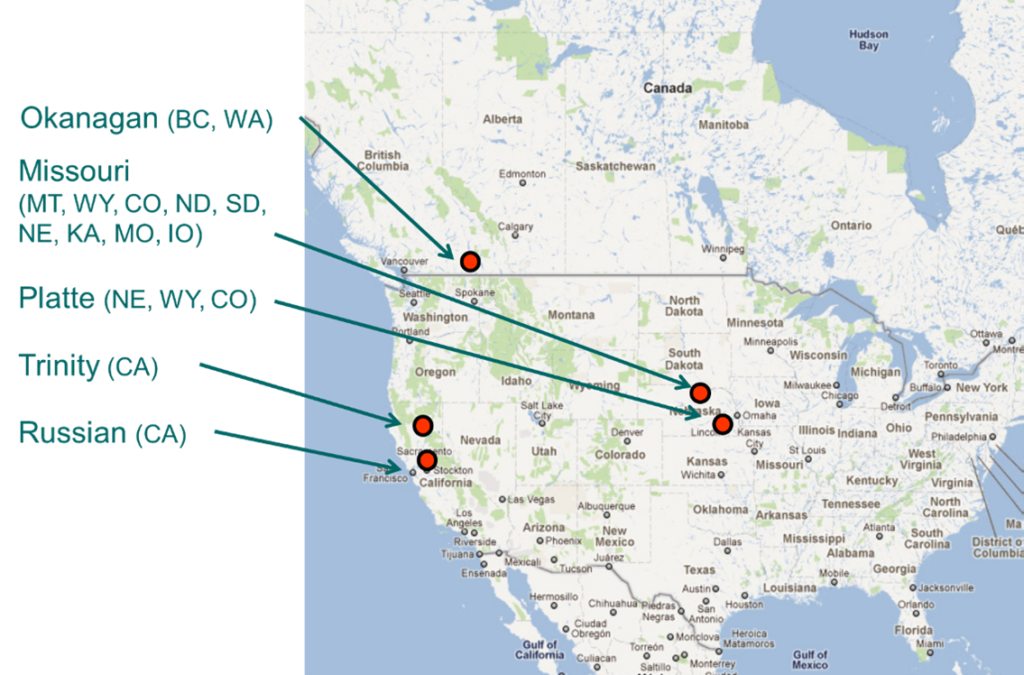
Figure 1 River basins (states / provinces) where ESSA has participated in AM projects to restore watersheds and recover listed species.
Dry Creek (CA). This project involves the creation of side channels, alcoves and other habitat features over 6 miles of Dry Creek, a 14-mile tributary of the Russian River, just north of Santa Rosa CA (basin area = 565 km2). The created features provide spawning and rearing habitats for coho salmon and steelhead, as well as refugia from winter storms. The project is implemented by the Sonoma County Water Agency (SCWA) within a rigorous AM framework collaboratively developed by ESSA (Porter et al., 2014). Up until the fall of 2016, the constructed habitats were being well utilized by both juvenile and adult salmon, as well as steelhead. Winter flows in December 2016 were about 40-50 times higher than normal (Figure 2), flooding the creek, some constructed habitats, adjacent vineyards and infrastructure. Alcoves and backwater ponds, which are only connected to Dry Creek at their downstream end, generally withstood the December 2016 high flows (Gregg Horton, SCWA, pers. comm. 2017). However, some side channels connected to Dry Creek at both their upstream and downstream ends, received over a meter of sediment as the storm eroded banks and moved material downstream, completely filling and blocking the side channels at their upper end.
Trinity River (CA). Reservoirs and dams on the Trinity River were completed in 1964, diverting up to 90% of its flow into the Sacramento River Basin for power generation and irrigation of agricultural land in the Central Valley of California. A Record of Decision (ROD) was signed in 2000 to restore the Trinity River within an AM framework, increasing flows to about 50% of the original inflows, and rehabilitating the channel, manipulating flows, adding gravel, and reducing fine sediment inputs. ESSA has helped to guide the application of AM in the Trinity watershed since 2004. Droughts during 2013-2015, while not unprecedented, drained the main storage reservoir (Trinity Lake) down to its lowest level since 1977. Salmon would likely have been exposed to potentially lethal water temperatures if 2016 had also been a dry year, as it would no longer have been possible to maintain a cold-water pool in Trinity Lake and release cold water for salmon (John Bair, McBain Associates, pers. comm., 2017). Fortunately, 2016 was a wet year, and the storage in Trinity Lake was replenished (Figure 3).
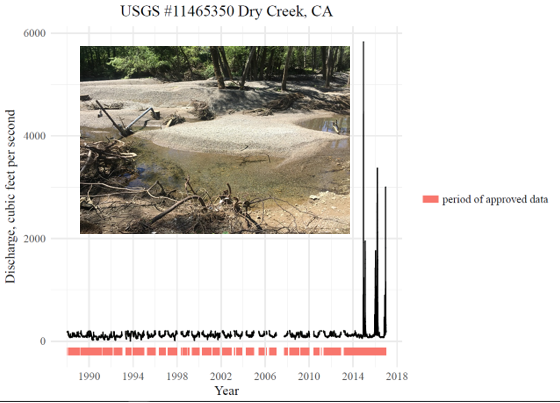
Figure 2 Discharge in Dry Creek CA from 1988 to 2016 at Healdsburg CA. Source: USGS https://waterdata.usgs.gov/nwis/dvstat/?referred_module=sw Inset: picture of a constructed side channel loaded with sediment after the December 2016 high flows
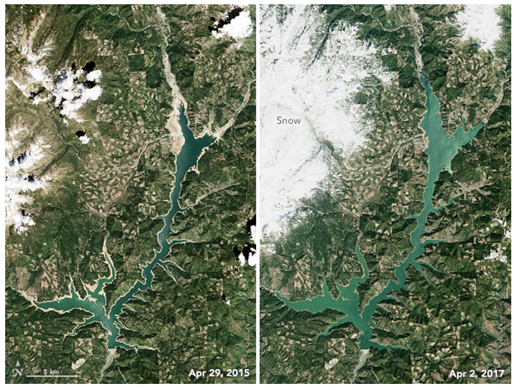
Figure 3 Area of Trinity Lake on April 29, 2015 (left, during the drought) and April 2, 2017 (right, post-drought). Source: https://earthobservatory.nasa.gov/images/90062/california-reservoirs-rise-from-drought-to-deluge
Okanagan River (BC). Starting in 2002, a collaborative working group led by ESSA developed a real-time decision tool for managing water flows out of Okanagan Lake, called the Fish Water Management Tool or FWMT (Hyatt et al., 2015). FWMT uses real-time, web-accessible information on snowpack, lake levels, stream temperatures and stream flows to help managers make the best possible decisions on how much water to release each week from Okanagan Lake. There has been a 600% increase in the abundance of Okanagan sockeye (measured as spawners) over the last 15 years (Kim Hyatt, Fisheries and Oceans Canada, pers. comm., 2018), reflecting multiple causes (higher ocean survival, improved freshwater habitat, improved freshwater survival using FWMT, range expansion). With climate change, we predicted drier conditions and a significant decrease in smolt production. But 2017 contradicted our expectations. An atmospheric river dropped 40 mm of rain during the first six days of May, melting much of the surrounding snowpack. Then in late May temperatures reached unseasonably warm levels (20-23oC), which caused further rapid snowmelt. By June 3rd, the elevation of Okanagan Lake was at its highest level in 200 years, causing severe flooding (Figure 4), and unknown effects on sockeye.
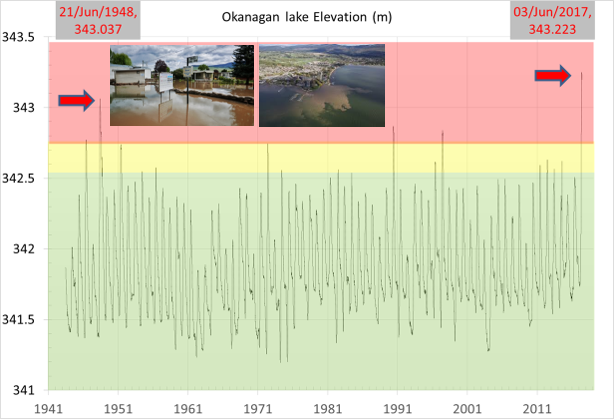
Figure 4 Elevations in Okanagan Lake, southeastern British Columbia, from 1941 to 2017. Colors represent various levels of estimated damage from flooding associated with lake elevations: green (<$1.5M CAN), yellow ($1.5M to $17M), red (> $17M). Inset pictures: flooding during 2017.
Platte River (NE, WY, CO). The focus of this AM effort (the Platte River Recovery Implementation Program PRRIP) is to restore habitat for endangered interior least terns, Northern Great Plains Piping plovers, and whooping cranes in a 150-mile Program area near Kearney, Nebraska, while protecting uses of the Platte River by pallid sturgeon (Smith, 2010). ESSA has provided independent scientific advice to the PRRIP since 2005. Two alternative approaches have been tested to create and maintain nesting habitat for least terns and piping plovers: 1) using flow and sediment augmentation to have the river naturally build sandbars; and 2) using off-channel sandpits adjacent to the river as nesting habitat. The first approach has been unsuccessful. Extended periods of high flow in recent years have eroded both natural and constructed sandbars (approach 1), while off-channel sandpits (approach 2) are protected from high flows and continue to be the only habitats used by terns and plovers for nesting. One of the flow hypotheses being tested in the Platte was that 3 days of flow at 5,000 to 8,000 cfs (142 to 227 m3/s; “Short Duration High Flows”, SDHF), would build in-river sandbars suitable for bird nesting. Though it isn’t feasible to release exactly that amount of flow, seven natural flow events occurred over the last decade (Figure 5), which were of equal or greater magnitude and duration, and allowed scientists to test (and reject) the SDHF flow hypothesis for this part of the Platte River. Anomalously high or low flows (relative to the historical record) are an opportunity for learning.
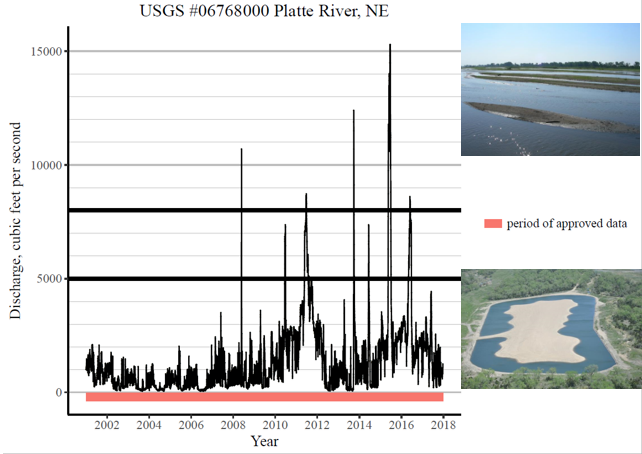
Figure 5 Flows in the Platte River over the period from 2001 to 2017. The thick horizontal lines indicate the flow range from 5,000 to 8,000 cfs hypothesized to create sandbars in the river (142 to 227 m3/s; note the log scale),. Since 2008 there have been seven flow events either within or above that range of flows. Inset photos show in-river sandbars (top) and off-channel constructed habitat at sandpits. Source: USGS https://waterdata.usgs.gov/nwis/dvstat/?referred_module=sw’
Missouri River (MT, WY, CO, ND, SD, NE, KA, MO, IO). The Missouri River Recovery Program (MRRP) is focused on not jeopardizing the continued existence of piping plovers, least terns and pallid sturgeon (3 of the 4 species addressed in the Platte Program), while at the same time minimizing negative impacts to human uses of the river. Actions such as habitat construction for both birds and fish, passage for pallid sturgeon on the Yellowstone River, and flows to encourage sturgeon spawning are analyzed and implemented within a rigorous, step-wise AM framework co-authored by ESSA scientists (Fischenich et al., 2018). In 2011, higher-than-average snowmelt runoff combined with heavy spring rains caused a very large flood in the Missouri River (Figure 6). Some locations in the Missouri River subbasin received one-half of their normal annual rainfall during the second half of May 2011 (Vining et al., 2013). The flood caused considerable damage to property (Figure 6), but also produced a 15-fold increase in the amount of sandbar habitat available for nesting terns and plovers in the Lower Missouri River (Fischenich et al., 2018) and led to successful spawning by pallid sturgeon in the Upper Missouri River (a very rare event). There is an understandable nervousness among stakeholders to deliberately increasing flows to create sandbar habitat for piping plovers or encouraging pallid sturgeon to spawn. Over 2022-2023, extensive discussions with stakeholders led to the successful implementation of an AM experiment in 2024: attraction and spawning flows for pallid sturgeon in the Upper Missouri River. Tracking of telemetered fish showed upstream movement coincident with an increase in flows in late April, and successful spawning by a hatchery-origin female occurred in July 2024, the first documented spawning since 2011.
Synthesis and a Way Forward
There are three major climate challenges which emerge from these case studies: 1) extreme runoff and flow events can destroy habitat and property (though they also may create habitat); 2) decreasing precipitation can cause longer periods of drought and negative impacts on biota; and 3) the scale of climatic impacts and required intervention is much greater than the scale of feasible management control. In our 2019 paper (Marmorek et al. 2019), we describe seven strategies to deal with these challenges, each of which has either been implemented or is under consideration in one or more of these projects (Table 1). This is just a subset of many possible CCA strategies which could be implemented (see Table 2 in Salafsky et al. 2008).
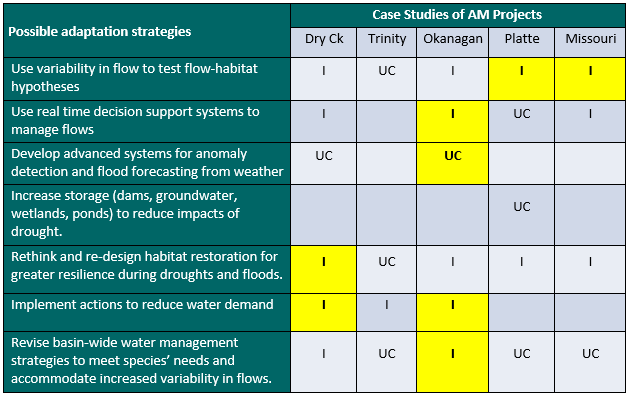
Table 1 Status of implementation of strategies to adapt to climate challenges. I = Implemented. UC = Under Consideration. Highlighted and bolded cells provide the strongest examples of where each strategy has been implemented.
Climate change and extreme climatic events pose significant risks for AM projects that are attempting to restore ecosystems and recover species. Climate risks could be substantially reduced (and some opportunities realized) by applying the principles and procedures of CCA during the assessment, design and implementation steps of new AM projects, and the adjustment step of existing AM projects. On the flip side, CCA practitioners could obtain multiple benefits by applying the rigor of AM, improving the rate of learning regarding which actions are most effective in adjusting to climate change. We hope that practitioners in both fields will harness the complementary strengths of AM and CCA. Doing so is akin to shifting from monocular to binocular vision. Or, in haiku form:
| Using CCA
In AM project design Builds resilience! |
Applying AM To climate adaptation Will improve learning! |
Bringing these fields together will require adjustments in the way practitioners in both fields understand and do their work. We have the following recommendations for practitioners involved in planning or implementing AM projects to restore aquatic ecosystems and/or recover species: 1) learn about the field of CCA (e.g., Stein et al., 2014; CCME, 2015); 2) do (or redo) the assessment step of the AM cycle for your project in a manner that rigorously considers the potential effects of future climatic variation; 3) rethink the design and implementation steps of your AM project in light of your climate-aware assessment, considering the seven strategies outlined in Table 1 to reduce climate risks, increase project resilience, realize opportunities to benefit from increased climate variability (e.g., testing hypotheses, creating habitat), and consider collaborative strategies for CCA at much larger spatial scales than the scale of your AM project; 4) review the monitoring and evaluation activities currently in place (or planned) for your project, revising them to enable greater elucidation of climate effects on project objectives; and 5) share your climate insights with other AM professionals.
For practitioners of CCA, we recommend the following: 1) learn about AM (e.g., Williams et al., 2009, Williams and Brown, 2012); 2) take advantage of the four decades of AM practice to make a quantum leap in the level of rigor applied to the design, implementation, monitoring and evaluation of CCA actions; 3) institutionalize learning into the paradigms applied by managers of CCA programs; and 4) share your AM insights with other professionals in the field of CCA.
References Cited
Alfaro, R.I., L. van Akker, B. Hawkes. 2015. Characteristics of forest legacies following two mountain pine beetle outbreaks in British Columbia, Canada. Can. J. For. Res. 45: 1387–1396 (2015) https://doi.org/10.1139/cjfr-2015-0042
Baum, K.B., C. Tait, J. Hunter, M. Mcclearn. 2021. How B.C.’s string of natural disasters are connected. Globe and Mail. November 20, 2021. https://www.theglobeandmail.com/canada/article-how-bcs-string-of-natural-disasters-are-connected/
Canadian Council of Ministers of Environment (CCME). 2015. Implementation Framework for Climate Change Adaptation Planning at a Watershed Scale. PN 1529. ISBN 978-1-77202-011-3. https://www.ccme.ca/files/Resources/climate_change/Climate%20Change%20Adaptation%20Framework%201.0_e%20PN%201529.pdf (Accessed May 9, 2019)
Canadian Forest Service. 2021. Mountain pine beetle. https://www.nrcan.gc.ca/our-natural-resources/forests/wildland-fires-insects-disturbances/top-forest-insects-and-diseases-canada/mountain-pine-beetle/13381
Environment Canada 2021. Canada’s top 10 weather stories of 2021. https://www.canada.ca/en/environment-climate-change/services/top-ten-weather-stories/2021.html
Fischenich, J.C., K.E. Buenau, J.L. Bonneau, C.A. Fleming, D.R. Marmorek, M.A. Nelitz, C. L. Murray, B.O. Ma, G. Long and C.J. Schwarz. 2018. Science and Adaptive Management Plan + Appendices and Attachments. Report prepared for the U.S. Army Corps of Engineers, Washington, DC. 503 pp. https://www.nwo.usace.army.mil/mrrp/mgmt-plan/ (accessed May 9, 2019)
Hyatt, K.D., C.A.D. Alexander and. M.M. Stockwell. 2015. A decision support system for improving “fish friendly” flow compliance in the regulated Okanagan Lake and River System of British Columbia, Canadian Water Resources Journal 40:1, 87-110, DOI: 10.1080/07011784.2014.985510
Kurz, W.A., C.C. Dymond, G. Stinson, G.J. Rampley, E.T. Neilson, A.L. Carroll, T. Ebata and L. Safranyik. 2008. Mountain pine beetle and forest carbon feedback to climate change. Nature 452: 987-990.
Marmorek, D., M. Nelitz, J. Eyzaguirre, C. Murray, and C. Alexander. 2019. Adaptive Management and Climate Change Adaptation: Two Mutually Beneficial Areas of Practice. Journal of the American Water Resources Association 55 (4): 881–905. https://doi.org/10.1111/1752-1688.12774
Salafsky, N., D. Salzer, A.J. Stattersfield, C. Hilton-Taylor, R. Neugarten, S.H.M. Butchart, B. Collen, N. Cox, L.L. Master, S. O’Connor and D. Wilkie. 2008. Conservation Biology 22 (4): 897-911.
Smith, C.B. 2010. Adaptive management on the central Platte River – Science, engineering, and decision analysis to assist in the recovery of four species. J. Env. Mgmt. Volume 92, Issue 5,Pages 1414-1419. https://www.sciencedirect.com/journal/journal-of-environmental-management/vol/92/issue/5
Stein, B.A., P. Glick, N. Edelson, and A. Staudt (editors). 2014. Climate-Smart Conservation: Putting Adaptation Principles into Practice. National Wildlife Federation, Washington, D.C. https://www.nwf.org/~/media/PDFs/Global-Warming/2014/Climate-Smart-Conservation-Final_06-06-2014.pdf (accessed May 9, 2019)
Vining, K.C., Chase, K.J., and Loss, G.R., 2013, General weather conditions and precipitation contributing to the 2011 flooding in the Mississippi River and Red River of the North Basins, December 2010 through July 2011: U.S. Geological Survey Professional Paper 1798–B, 22 p. https://pubs.usgs.gov/pp/1798b/ (accessed May 9, 2019)
White, P. 2021. B.C.’s devastated highways are slowly reopening, but a full recovery won’t take place until next year. Globe and Mail. November 20, 2021. https://www.theglobeandmail.com/canada/article-bcs-devastated-highways-are-slowly-reopening-but-a-full-recovery-wont/
Williams, B.K., and E.D. Brown. 2016. Technical challenges in the application of adaptive management. Biological Conservation 195 (2016) 255–263 http://dx.doi.org/10.1016/j.biocon.2016.01.012
Williams, B. K., R. C. Szaro, and C. D. Shapiro. 2009. Adaptive Management: The U.S. Department of the Interior Technical Guide. Adaptive Management Working Group, U.S. Department of the Interior, Washington, DC. https://www.doi.gov/sites/doi.gov/files/migrated/ppa/upload/TechGuide.pdf (accessed May 9, 2019)
